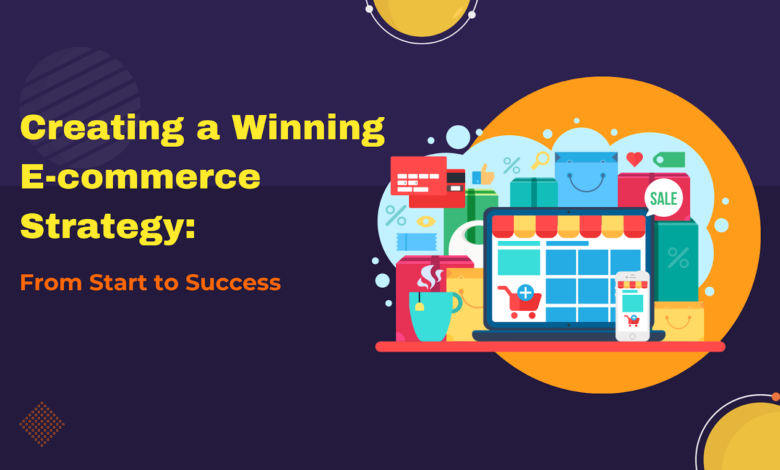Creating a Winning E-commerce Strategy: From Start to Success

Do you have an e-commerce platform or do you plan to start one? We understand your struggles in delivering your products to the target audience. You are at the right place.
The market is flooding with startups. If you are not keeping up with the trends you may drown. Follow this step-by-step guide to create a winning strategy. It will drive sales and growth for your online business. With the right plan, targeted campaigns will help you thrive. Read on to learn key steps for a winning e-commerce strategy.
Understanding Your Target Audience
To make a smart plan, first get to know your customers inside out. Figure out:
- Their age, location, income, and other details.
- What they care about and enjoy.
- Problems they deal with and needs you can meet.
- How they shop and what sways their choices.
Tools like Google Analytics and social media analytics give data-driven insights into your existing customers. Surveys, interviews, and focus groups uncover details about their motivations and thought processes. Map out your target personas based on technographics, shopping habits, and channel preferences.
This deep understanding helps tailor your strategies to their specific needs. The key is studying real people. Learn what makes each audience unique. Use what you discover to shape an e-commerce strategy that speaks to their lives.
Analyzing Your Competitive Landscape
Here are some tips for doing a thorough SWOT analysis to develop strong strategies:
- Compare your product, pricing, service, website, and branding. Find where you excel or fall short.
- Study trends, tech, regulations. Spot chances to grow or risks ahead. Consider the short and long term.
- Research competitors online – social, reviews, job sites. Gauge their market share and innovations.
- Pinpoint where competitor products or services fall short. Find gaps so you can fill the niche better.
- Watch competitors’ moves – product launches, promos, content. Weigh threats to your business.
- Talk to experts to get wider views on opportunities and blind spots.
This broad look inside and outside your business builds smart strategies. It helps you play to strengths, fix weaknesses, stand apart from others, and seize promising openings.
For startups, a digital marketing agency is necessary. Their expertise will guide you to get attention and stand out with limited budgets. A digital marketing agency for startups can provide crucial support during the early stages. They understand how to create buzz and get the word out with limited resources.
Their knowledge of social media, SEO, and digital advertising helps startups stand out in a crowded market. A specialized agency helps startups maximize impact with targeted, strategic digital marketing campaigns.
Defining Your Goals and KPIs
Having clear business goals is crucial for keeping strategies aligned with overall growth. Define specific, measurable goals around:
- Customer acquisition: Number of new customers in a defined period.
- Engagement: Time on site, repeat purchases, email open rates, etc.
- Conversions: Sales, lead generation, newsletter sign-ups, etc.
- Revenue: Overall and growth rate over time.
- Brand awareness: Increase in traffic, followers, mentions, etc.
Alongside goals, identify 2-3 Key Performance Indicators or KPIs for each. For instance, monthly sales growth could be a KPI for the revenue goal. Revisit goals quarterly to track progress. Update strategies as needed to boost outcomes.
Crafting a Strong Value Proposition
Your value proposition is a brief statement. It says why your brand is different. It explains why customers should care about your business. The value proposition directly speaks to your target audience.
It focuses on the needs, wants, and pain points you uncovered during personal research. It talks about if you are worth your customer’s time, attention, and money. It highlights what makes you stand apart from competitors.
Elements of an effective value proposition
- Headline: Summarize what makes you unique in one line. Avoid generic claims. Focus on your key benefit.
- Description: Explain in 2-3 lines how you uniquely solve customer issues. Use numbers to quantify benefits.
- Social Proof: Add testimonials, reviews, and awards. Back up your claims.
- Visuals: Use graphics, icons, and images that support the headline. Ensure visuals match your brand identity.
For example, an organic skincare brand’s value proposition could be:
“Youthful, glowing skin with 100% farm-fresh organic ingredients”
Our range gently nourishes your skin through the powerful properties of potent botanical and herbal extracts. No harsh chemicals or artificial fillers – just wholesome goodness from nature.
An effective value proposition distills why customers should buy from you over competitors. It guides marketing campaigns and product positioning. Avoid generic claims and include unique details based on personal insights to craft a compelling statement. Test variations with current customers to identify the most persuasive mix.
Optimizing Operations and Technology
E-commerce success depends heavily on back-end infrastructure that delivers seamless customer experiences. Invest in technology and tools for:
- User-friendly website: Easy navigation, intuitive flows, mobile responsiveness.
- Secure payments: Offer preferred payment modes; ensure robust fraud protection.
- Order fulfillment: Integrate systems for prompt processing and delivery.
- Customer service: Omnichannel support through calls, email, chat, and social media.
- Data analytics: Track KPIs and gain customer insights using tools like Google Analytics.
- Marketing automation: Email nurturing, personalized messaging, and promotions through platforms like MailChimp.
Workflows should be optimized to provide quick resolution and excellent service at all customer touchpoints.
Executing Through Actionable Campaigns
With your strategic foundations in place, the next step is execution via targeted campaigns across channels.
- Search engine optimization: keyword research, website optimization, local SEO, backlinks, etc.
- Paid advertising: Google Ads, Facebook ads, Amazon ads, etc. targeted using personal data.
- Email marketing: lead nurturing and promotion through campaigns personalized based on metrics like purchase history and on-site behavior.
- Social media marketing: organic and paid campaigns tailored to platform-specific audiences.
- Content marketing: blogs, videos, guides, etc. focused on topics and keywords valuable to your audience.
- Referral programs: incentivize existing customers to promote your brand.
- Partnerships and influencer outreach: co-create value through strategic collaborations.
- Retargeting campaigns: win back visitors who left without purchasing using personalized messaging.
Track performance diligently and optimize efforts regularly to maximize ROI.
Conclusion
An effective strategy is the key to e-commerce success. Conduct thorough research, optimize operations, provide value to your audience, and keep improving. With diligent execution and consistent fine-tuning, your online business can gain a competitive edge. So go ahead, craft that winning game plan, and achieve sustainable growth!
FAQs
- How do I identify my target audience?
Get to know your customers. Use analytics, surveys, interviews, and focus groups. Learn about their lives, values, problems, and shopping preferences.
- What tools can help me study competitors?
Make use of analytics tools, social media, reviews, and forums. Compare against competitors in all areas.
- How often should I refine my ecommerce strategies?
Check your monthly stats. Upgrade your tactics regularly. Keep up with shifting customer needs and the market. Make small but steady improvements over time.



